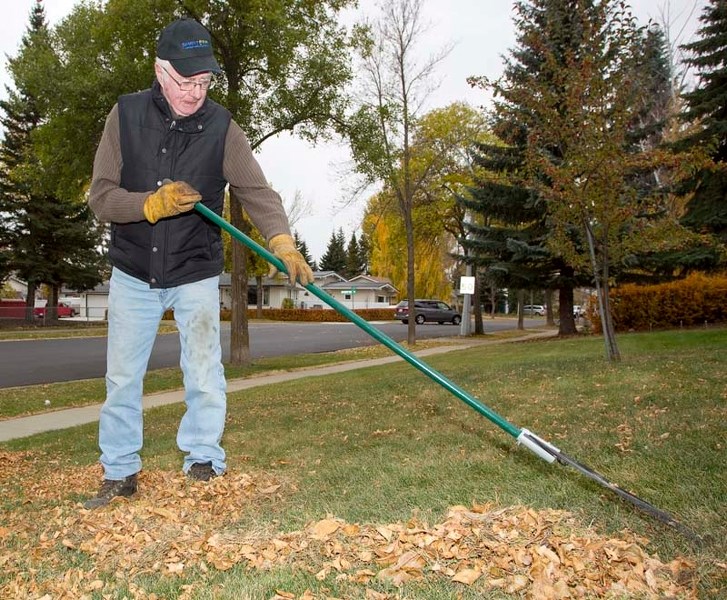To cut, or not to cut is the problem most gardeners face when it comes to fall cleanup.
There are two schools of thought about cutting down plants and perennials in the fall. One school says it's better for plant health to cut down the perennials in the fall because you reduce the number of places for insects and diseases to hide. The other school says that if you don't cut back the peonies, irises and day lilies, you have more leaves to hold the snow and moisture.
Jim Hole, of Hole's Greenhouses and Gardens, believes it's easier to put the garden to bed now. In addition, cleaning the lawn of debris now reduces the incidence of snow mould. Cleaning and trimming dry perennials in the fall is also easier than trying to pull them down in the spring.
"It's 50 per cent plant health and 50 per cent psychological. I'd say cut them back now because the insulation value of those leaves and the amount of moisture they hold isn't that great. And it's tidier looking now and one less job to do in the spring. Plus, when the snow goes next spring, it's pretty discouraging to see a mess of wet, mouldy leaves," Hole said.
Lawn maintenance
Every weekend since May, you've been out there fertilizing and mowing and trimming the edges of the grass. It's time to take a break, but there are some things to do in October, to help keep the lawn healthy.
• Cut the grass short. Doing this has added advantage of allowing you to pick up leaves at the same time (with most lawn mowers.)
"The lawn is into dormancy now, so there's no point now in aerating it. I'd wait until next spring to aerate or dethatch the lawn," said Hole.
It's also too late to seed bald patches of lawn, so save seeding and fertilizing until the spring, Hole said.
Flower containers should also be cleaned out and washed with a mild bleach solution.
"Bleach is the way to go to get them sanitized. Clean your pots," Hole said.
Wait for the leaves
When it comes to trimming perennials such as irises and daylilies, Stephen Raven of Hole's Greenhouses recommends waiting as long as possible, until the foliage turns yellow.
"Ideally, that's the best. I've already cleaned up my own perennials but when you do that, you take a risk, because if it warms up, and we get a really warm Indian summer, the plants might start to grow again," Raven said.
Raven explained that having no foliage gives the plants the message that it's time to grow, because without leaves they have no way to get energy or food. Once the cold weather hits, the plants become dormant.
Raven has 150 tender tea roses in his own yard and he plans to spend this weekend cutting them back and covering them with a mound of peat moss.
"Again, it's a bit of a risk, because if it gets too warm, they could cook under that peat moss. Or they might think, 'Ooh. It's warm. I'd better get growing.' And then they get hit with a hard frost," Raven said.
Raven cuts his rose canes back until they are about one-foot tall. Then he covers them with peat moss. To hold the moss in place and keep it from blowing away, he sprinkles the moss with water from a watering can.
The tender roses at the St. Albert Botanic Park are prepared in much the same way, except that the roses are usually covered with dry leaves and protected with a box.
"Usually the canes are cut back and protected with a box. Liquor boxes work well and contain the dry leaves. Then the box is closed at the top and can even be covered with plastic to keep it dry, and held in place with a rock," said Ed Toop, retired professor of horticulture and a volunteer at the park.
Once spring comes, it sometimes seems like a long wait, but the leaves on the tree are a good signal about when it's time to uncover the roses. When the trees start to leaf out, it's time to get the roses growing again.
Protect the trees
The trees at the St. Albert Botanic Park also get some babying to prepare them for winter, Toop said.
"We have a problem with deer. They are a real menace, and in fact some people say that whole herds of them sleep in the park. They rub the trees with their antlers," he said.
Park volunteers put plastic coils around the younger trees to protect the bark. The plastic coils also help to protect against damage from mice.
In the home garden, orchard trees such as Evans cherries and some crabapples, could suffer from sun scald, Toop said. When the trees are in an open area, facing south, they could heat up on an early spring day. The heating causes the sap to run, and then the sap freezes when it gets cold.
"One solution is to paint the bark with whitewash, because the white reflects the radiation. You could also make a simple burlap screen to protect the trees and the plastic coils could protect the younger trees too," Toop said.
Toop also likes to give the trees water before freeze-up. They don't have to be saturated, he said, but it has been a dry fall and a bit of water around the drip line of the trees will help them to grow in the spring.




